04 December 2020 How To Prevent Hearing Loss - ABL's Handy Guide
Protect Your Hearing With Earplugs & Earmuffs!
Hearing Loss Is One Of The Most Widespread Yet Preventable Workplace Injuries
How Can We Help?
There are times when we know the environment is going to be loud. Whether this is at work or not.
Knowing this allows us to prepare for a noisy environment by taking precautions (such as earmuffs or earplugs) to protect ourselves from suffering any sort of permanent hearing loss.
The loss of hearing has a dramatic impact on the quality of life and can contribute to many other safety problems such as, lack of awareness and reduced concentration.
Ear protection that has been designed and fitted correctly will keep industrial noise below the harmful levels, so the choice of an appropriate ear protection device is extremely vital!
When Does Noise Become Harmful?
Safe Work Australia states that standard noise exposure is 85dB averaged over 8 hours.
The table below displays the length of time a person (without hearing protection i.e. earplugs or earmuffs) can be exposed before this standard is exceeded:
Noise Level dB |
Exposure Time |
||||||||
| 80 | 16 Hours | ||||||||
| 82 | 12 Hours | ||||||||
| 85 | 8 Hours | ||||||||
| 88 | 4 Hours | ||||||||
| 91 | 2 Hours | ||||||||
| 94 | 1 Hour | ||||||||
| 97 | 30 Minutes | ||||||||
| 100 | 15 Minutes | ||||||||
| 103 | 7.5 Minutes | ||||||||
| 106 | 3.8 Minutes | ||||||||
| 109 | 1.9 Minutes | ||||||||
| 112 | 57 Seconds |
||||||||
| 115 | 28.8 Seconds | ||||||||
| 118 | 14.4 Seconds | ||||||||
| 121 | 7.2 Seconds | ||||||||
| 124 | 3.6 Seconds | ||||||||
| 127 | 1.8 Seconds | ||||||||
| 130 | 0.9 Seconds |
Noise levels greater that 140dB commonly occur with impact or explosions such as jack-hammering, gun shots etc. Any exposure above this peak can create almost instant damage to someone's hearing.
Any exposure to noise levels greater than 85dB could potentially cause hearing loss.
Safe Work Australia states that for workers to work safely, they must be able to hear warning signals above the ambient noise.
Some situations require at least 65dB and more than 15dB greater than the ambient noise level at any position in the signal reception area.
If you require more information regarding these requirements they can be found in ISO 7731:2003 Ergonomics - Danger signals for public and work areas - Auditory danger signals.
Hazardous noise isn't always obvious but by incorporating hazard identification into your safety procedures you can work out which activities within the workplace could potentially contribute to hearing loss or other harm (caused by noise).
EXAMPLE |
|
|
CLASS |
|
|
SLC dB |
|
|
ALLOWABLE NOISE |
| SAFE RANGE | |||||||||
| Ringing Telephone - 80dB | 1 | 10-13 | Less than 90dB | ||||||
| Loud Radio - 80dB | 1 | 10-13 | Less than 90dB | ||||||
| Busy Traffic - 80dB | 1 | 10-13 | Less than 90dB | ||||||
| Band Saws - 85dB | 2 | 10-13 | Less than 90dB |
||||||
| RISK RANGE | |||||||||
| Lawn Mower - 90dB | 2 | 14-17 | 90 - 95dB | ||||||
| Tractor - 96dB | 3 | 18-21 | 95 - 100dB | ||||||
| Electric Drill - 98dB | 3 | 18-21 | 95 - 100dB | ||||||
| Bulldozer - 105dB | 4 | 22-25 | 100 - 105dB | ||||||
| HARMFUL RANGE | |||||||||
| Blasting - 110dB | 5 | 26-36 | 110 - 115dB | ||||||
| Chainsaw - 120dB | 5 | 26-36 | 115 - 120dB | ||||||
| Gun Shot - 130dB | 5 | 26-36 | 125 - 130dB | ||||||
| Jet Engine - 140dB | 5 | 26-36 | 135 - 140dB |
**This is a general guide only and is not an absolute basis for noise level selection as equipment may operate at different noise levels. Every work site should be tested and reviewed by Work Safe.
But How Do I Choose My Hearing Protection?
Hearing protection such as earmuffs and earplugs are used to reduce noise to a safe level for the wearer to prevent hearing loss/damage while still allowing the individual to hear warnings and instructions.
Generally speaking, wearing hearing protection should provide a similar effect to if you were to cup your hands over your ears.
The main criteria when selecting hearing protection is that the noise level entering the wearer's ears needs to be reduced to below the legal limits outlined in the Work Health and Safety Regulation 2011.
- an 8-hour equivalent continuous A weighted sound pressure level of 85 dB(A), referenced to 20 µPa, determined in accordance with 1269.1:2005 (Occupational noise management – Measurement and assessment of noise immission and exposure).; or
- a C-weighted peak sound pressure level of 140 dB(C), referenced to 20 µPa, determined in accordance with 1269.1:2005 (Occupational noise management – Measurement and assessment of noise immission and exposure).
Before choosing hearing protection you must first know 'who' is exposed, 'what' their exposure levels are and 'whether' or not the hearing protection is compatible with the working environment and other require PPE.
Hearing protection should have been tested in accordance to Australian Standard 1270. Test results are found on the packaging of the product and results are normally stated as SLC80, Class or NRR.
When selecting appropriate hearing protection you need to ensure the rating of the product is suited to the noise level and will protect the wearer in accordance with the above mentioned standard.
How Is Hearing Protection Tested In Australia And New Zealand And What Standards Apply?
Stated in the Australian Standard 1270 are two methods for testing hearing protection products.The SLC80 Method and The Class Method.
The SLC80 Method
The workplace noise is measured in C-weighted sound pressure levels as average over the shift, [LCeq,8h]. The SLC80 (Sound Level Conversion valid for 80 per cent of the wearers) of the hearing protector indicates the difference between the measured C-weighted sound pressure level of the workplace noise outside the hearing protector and the A-weighted sound pressure level, attenuated by the hearing protector, under the hearing protector inside the ear canals.
For example, the noise level in a workplace was 105 dB(C) (as average over the shift). The target ‘in-ear’ noise level is 80 dB(A). The minimum SLC80 required for a hearing protector in this workplace would be: SLC80 rating = 105 dB(C) - 80 dB(A) = 25
The Class Method
For this method we only need the 8-hour
average value in dB(A) [LAeq,8h], to which the
worker is exposed. AS/NZS 1269.3 lists noise
level ranges for the five different classes of
hearing protectors and their relationship to the
above SLC80 rating, in Tables A1 and E1. A
combination of Table A1 and E1 is shown below.Table A1 and E1
AS/NZS 1269.3
| Class | LAeq,8h dB(A) | SLC 80 Range | ||||
| 1 | Less than 90 | 10 - 13 | ||||
| 2 | 90 to less than 95 | 14 - 17 | ||||
| 3 | 95 to less than 100 | 18 - 21 | ||||
| 4 | 100 to less than 105 | 22 - 25 | ||||
| 5 | 105 to less than 110 | 26 or greater |
For example, if a worker operating a four-inch angle grinder is exposed to 98 dB(A) as average over the 8-hour shift [LAeq,8h = 98 dB(A)], then a Class 3 hearing protector must be worn by that worker. The SLC80 rating of the hearing protector for the operator of the four-inch angle grinder therefore must be between 18 and 21.
Note - Noise Reduction Rating (NRR) system is used in the USA, but is not acceptable in Australia as the method of testing is different from the AS 1270 test method.
3M #1100 Plain Earplugs
|
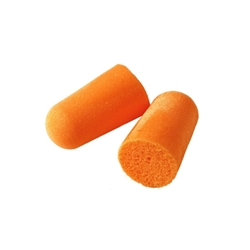 |
E-A-Rsoft Superfit Foam Earplugs
|
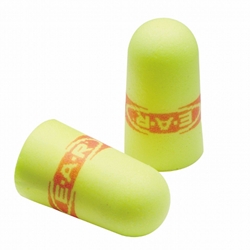 |
3M #1110 Corded Plain Earplugs
|
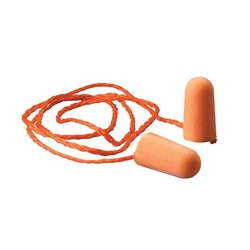 |
Viper Earmuffs
|
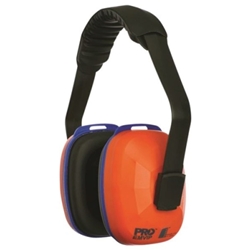 |
3M H7 Peltor Earmuffs
|
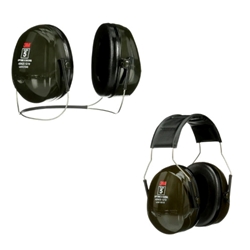 |




